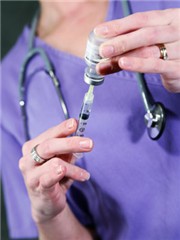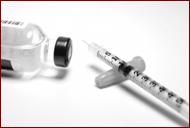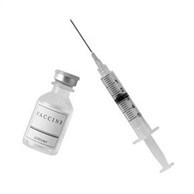October 2009 Volume 25, Number 13 Special Edition
New York State Medicaid Update
The official newsletter of the New York Medicaid Program
David A. Paterson, Governor
State of New York
Richard F. Daines, M.D. Commissioner
New York State Department of Health
Deborah Bachrach, Deputy Commissioner
Office of Health Insurance Programs
Medicaid Coverage and Reimbursement Policy for Seasonal Flu, Pneumococcal and H1N1 Vaccines
This Medicaid Update Special Edition explains the New York State initiative for seasonal flu, pneumococcal and H1N1 vaccines as well as Medicaid, Medicaid Managed Care and Family Health Plus coverage and reimbursement policies for the administration of these vaccines.
Seasonal Flu Vaccine

Two types of influenza vaccines exist that protect against seasonal flu. The "flu shot" is an inactivated vaccine (containing killed virus) that is administered with a needle, usually in the arm. The flu shot is approved for use among people six months of age or older, including healthy people and those with chronic medical conditions (including asthma, diabetes, and heart disease). A different kind of vaccine, called the nasal-spray flu vaccine (sometimes referred to as LAIV for Live Attenuated Influenza Vaccine or FluMist®), was approved in 2003. The nasal spray flu vaccine contains attenuated (weakened) live viruses, and is administered by a nasal sprayer. It is approved for use only among non high-risk people aged 2-49 who are not pregnant.
Each of the two types of seasonal influenza vaccines contain three influenza viruses, which are chosen based on information about recently circulating seasonal viruses. Each seasonal influenza vaccine contains - one A (H3N2) virus, one A (H1N1) virus (not the 2009 H1N1 virus), and one B virus. Viruses for both vaccines are grown in eggs.
Since seasonal influenza will occur at the same time as the 2009 H1N1 influenza, it is important for everyone to get a seasonal influenza vaccine as soon as possible. It is also advised that certain individuals be vaccinated against pneumococcal disease, which can sometimes occur after a viral respiratory infection, such as influenza.
For seasonal influenza vaccine recommendations, please see the Prevention and Control of Seasonal Influenza with Vaccines, MMWR July 31, 2009 / 58(RR08); 1-52 at: http://www.cdc.gov/MMWR/preview/mmwrhtml/rr5808a1.htm.
Pneumococcal Vaccine
Pneumococcal disease is a bacterial infection caused by the bacteria Streptococcus Pneumoniae, also called pneumococcus. It may cause middle ear infection, pneumonia, meningitis or bacteremia. Although anyone can contract pneumococcal disease, it occurs more frequently in infants, young children, African Americans, some Native American populations, the elderly, or in people with serious underlying medical conditions such as chronic lung, heart or kidney disease.

Two types of vaccines are currently in use. The pneumococcal conjugate vaccine (PCV7) contains protection against seven types of pneumococcal bacteria. The pneumococcal polysaccharide vaccine (PPV23) contains protection from 23 types of pneumococcal bacteria. Pneumococcal conjugate vaccine is recommended for all children less than 24 months old and for children between 24 and 59 months old who are at high risk of disease.
Adults older than 65 years of age and persons who are two years and older and at high risk for disease (e.g., sickle cell disease, HIV infection, or other conditions that weaken the immune system) should receive the pneumococcal polysaccharide vaccine. In New York State, pneumococcal conjugate vaccine (PCV7) is required for pre-kindergarten attendance for children born on or after 1/1/08.
H1N1 Vaccine
The 2009 H1N1 influenza virus began circulating in the United States during April 2009. It continued to cause illness over the summer months, and cases are now on the rise. This virus was originally referred to as "swine flu" since laboratory testing demonstrated that many of the genes in this virus were similar to influenza viruses that normally occur in pigs (swine) in North America.
The 2009 H1N1 influenza vaccine is currently in production. Initial doses of the vaccine became available in early October 2009. This H1N1 influenza vaccine is not intended to replace the seasonal flu vaccine - it is intended to be used alongside the seasonal flu vaccine. The 2009 H1N1 virus represents a threat because few people are immune to it, particularly children and young adults. This would put a severe strain on our health care system, and our communities, overall. Receiving the H1N1 vaccine is completely voluntary.
People aged 65 or older may wonder why they will not be offered the new vaccine against 2009 H1N1 influenza before anyone else, as they are usually at the highest risk of serious illness if they get the seasonal flu. This is based on data gathered during the Spring 2009 outbreak of H1N1 that indicated people 65 and older are least likely to get sick from H1N1. Scientists theorize that many older Americans might have been exposed to a similar flu virus during the first half of the 20th Century, and may have some immunity to 2009 H1N1 influenza.
2009 H1N1 Influenza Vaccine General Information

The 2009 H1N1 influenza vaccine is being produced by the same five manufacturers that produce seasonal influenza vaccines. This vaccine is:
- Formulated just like seasonal influenza vaccines but with a change in the influenza strain that is included;
- A monovalent vaccine that contains only the 2009 H1N1 influenza strain;
- A licensed vaccine;
- Available in both the injectable form and the nasal spray;
- Available in limited quantities without thimerosal;
- Available now in limited quantities, with more doses on the way;
- Provided at no cost by the Federal government;
- Able to be administered at the same time as seasonal influenza vaccine;
- Safe and effective with one dose required for adults and children 10 years and older, and 2 doses 3-4 weeks apart for children age 9 years and younger.
2009 H1N1 Influenza Vaccine Development Timeline
The 2009 H1N1 influenza vaccine is currently being manufactured and has undergone clinical trials. The clinical studies were conducted to confirm the final dosage of antigen in the vaccine, the number of doses required, the interval between the doses, any safety concerns, antibody responses to the vaccine, and other clinical information.
The vaccine became available in early October 2009, although in limited quantities. Currently, doses of H1N1 vaccine are limited, however, production is continuing and increased supplies are expected in November and December 2009. Safety issues should not be a cause for concern since this vaccine is being produced just like a seasonal vaccine.
Target Groups for 2009 H1N1 Influenza Vaccine
The Advisory Committee on Immunization Practices (ACIP) met on July 29, 2009, and made recommendations on who should receive the 2009 H1N1 influenza vaccine.

Following are some of the considerations regarding the epidemiology of the 2009 H1N1 influenza vaccine that were used to create the target groups: groups that had the most severe illness and risk for complications during the spring 2009 H1N1 outbreak; groups that had the greatest frequency of illness during the spring 2009 H1N1 outbreak; contribution of particular groups to the overall burden of severe illness; protection of healthcare system functions; reduction of societal impact; and potential for indirect protection of more vulnerable contacts.
PHASE I: The following groups of people are the initial focus for the 2009 H1N1 influenza vaccine:
- Pregnant women;
- Household contacts and caregivers of infants younger than 6 months of age;
- Health care personnel and emergency medical services personnel;
- Children, adolescents, and young adults 6 months through 24 years of age; and
- Adults 25 through 64 years of age with a medical condition that puts them at high risk for complications of influenza.
If the initial supply of 2009 H1N1 influenza vaccine is limited either nationally or on a local basis and there is not enough vaccine to cover the groups above, then the following groups of people will be recommended to receive this vaccine:
- Pregnant women;
- Household contacts and caregivers of infants younger than 6 months of age;
- Health care personnel and emergency medical services personnel who have direct patient contact;
- Children 6 months through 4 years of age; and
- Children and adolescents 5 through 18 years of age with a medical condition that makes them at high risk for complications of influenza.
PHASE II: Once it has been shown that there is enough vaccine to immunize the groups above, the next target group will be:
- All adults 25 through 64 years of age.
PHASE III: Once it has been shown that there is enough vaccine to immunize the groups above the next target group is:
- All adults 65 years of age and older.
2009 H1N1 Influenza Vaccine Methods of Distribution
Vaccine distribution will occur under the control of the NYSDOH for all counties outside of New York City. Vaccines will be distributed through a central distributor that is under contract with the Centers for Disease Control and Prevention (CDC). The NYSDOH will direct the central distributor, McKesson Corporation, to deliver vaccines to sites in New York State. The approximate number of sites that will be available to New York State is 5,800.
How will the New York State Immunization Information System (NYSIIS) be used for the H1N1 Vaccination Campaign?
The New York State Immunization Information System (NYSIIS) is a confidential and secure Web-based system that maintains one consolidated immunization record for persons of all ages in New York State (outside of New York City). Public Health Law 2168 mandates that health care providers report information on vaccinations administered to all persons less than 19 years of age. The NYSDOH is working on eliminating the requirement for separate written consent for individuals 19 years of age and older.
Providers who administer any immunization to persons less than 19 years of age are required by state law to report to NYSIIS. This includes the 2009 H1N1 influenza vaccine. Providers are strongly encouraged to use NYSIIS to track immunization information for persons 19 years of age and older. A recording procedure is currently being developed for those providers not on NYSIIS who will be vaccinating people 19 and older.
How will Private Providers, Pharmacists and Others Receive the 2009 H1N1 Influenza Vaccine?
REGISTRATION: All providers interested in receiving the 2009 H1N1 influenza vaccine must register at https://hcsteamwork1.health.state.ny.us/pub.

- This registration process is designed for providers to express their interest in the vaccine, however, it does not obligate them to receive or administer the vaccine, nor does it guarantee they will receive the vaccine if supplies are limited.
REQUIREMENTS FOR RECEIPT OF VACCINE:
- In order to receive the 2009 H1N1 influenza vaccine, providers must sign a federally mandated Provider Agreement agreeing to appropriately store and handle the vaccine, to administer vaccines only to CDC targeted groups, and to report vaccine usage.
Once the registration is received and the provider agreement has been signed, providers will be able to order vaccine by calling (800) KID-SHOT.
2009 H1N1 VACCINE REPORTING (DOSES ADMINISTERED AND DOSES WASTED)
Three options are available for reporting to the NYSDOH:
- New York State Immunization Information System (NYSIIS): Health care providers are required by Public Health Law 2168 to report all immunizations administered to children less than 19 years of age to NYSIIS. NYSIIS can also be used for reporting doses administered to persons 19 years of age or older, with consent
Inventory, including doses wasted, can be tracked using NYSIIS. An on-line tutorial for using the NYSIIS inventory module is available at: https://commerce.health.state.ny.us/hcsportal/docs/Source/hpn/bcdc/immunization/instantdemo/tutorials.html - Clinic Data Management System (CDMS): Only Local Health Departments have the ability to use CDMS to assist with managing the information related to the vaccination campaign.
- Interactive Voice Response (IVR) System (Telephone Reporting): Doses administered and vaccine inventory reporting for providers serving adults can be completed through the IVR system using a touch tone phone. Daily and Weekly Tracking logs are available to assist with compiling the information required for these weekly reports. The logs are attached below as Appendix A. Reporting must be completed by 11:59 p.m. each Monday for the week ending the previous Saturday by calling, 1-888-H1N1-VAC (1-888-416-1822) With regard to redistribution, the vaccine provider that received vaccine and redistributed it could collect the information and report on behalf of the redistributed sites using the end site H1N1 PIN #.
How will Health Care Facilities Access the 2009 H1N1 Influenza Vaccine?
All health care personnel and emergency medical service providers are within the initial target groups for the 2009 H1N1 influenza vaccine. All hospitals have received an allocation of the vaccine for use in their facility and will continue to order vaccine as needed by calling (800) KID-SHOT.
Vaccine Safety
The 2009 H1N1 influenza vaccine is manufactured in the same manner as the seasonal influenza vaccine. Studies will be conducted by the CDC and vaccine manufacturers to monitor for Guillain Barre Syndrome (GBS) and any unusual adverse events. New York State is setting up a system to receive GBS reports from neurologists and will carefully monitor the incidence of GBS in the state.
The Vaccine Adverse Events Recording System (VAERS) will be used to document reports of adverse events that occur after vaccination. The NYSDOH will receive reports from the CDC on any adverse events that occur in New York State on a regular basis. If an adverse event is suspected, please contact VAERS at (800) 822-7967 or visit http://www.vaers.hhs.gov
Additional Information/Resources
Additional information and resources on seasonal influenza and 2009 H1N1 influenza can be found at the following Websites:
- CDC/NCIRD - http://www.cdc.gov/ncird/
- NYSDOH - http://www.health.state.ny.us
- AAP - http://www.aap.org
- AAFP - http://www.aafp.org
- ACP - http://www.acponline.org
- ACOG - http://www.acog.org/
Medicaid Fee-For-Service Coverage of Seasonal Flu, Pneumococcal and H1N1 Immunizations
New York Medicaid will reimburse enrolled office-based practitioners, pharmacies, and Article 28 clinic providers for the administration of the H1N1 vaccine, for the cost of the seasonal flu and pneumococcal vaccines, and for the administration of these vaccines. The fee-for-service coverage policies and billing rules for seasonal flu, pneumococcal, and H1N1 vaccines in effect as of September 1, 2009 have been specifically designed to facilitate improved access to these vaccines and are outlined as follows:

- Since the H1N1 vaccine supplies will be provided by the Federal Centers for Disease Control (CDC) at no cost, Medicaid will not cover the cost of H1N1 vaccine and supplies and will only cover the cost of administration of the H1N1 vaccine.
- Medicaid will cover the cost of seasonal flu and pneumococcal vaccines and the administration of these vaccines.
- Fees for administering seasonal/H1N1 and pneumococcal vaccines have been increased. Medicaid previously did not pay a distinct administration fee, but instead instructed providers to add $2.00 to the vaccine actual acquisition cost. Medicaid is now reimbursing clinics, physicians and pharmacies $13.23 for vaccine administration, and reimbursing nurse practitioners/licensed midwifes $11.25.
- Administration of seasonal flu, pneumococcal and H1N1 vaccines must be provided in Article 28 clinic settings; in a practitioner's office by a physician, physician's assistant, nurse practitioner, licensed midwife, registered nurse or licensed practical nurse; or, for ages 18 and older, in a pharmacy by certified pharmacists (within their respective scopes of practice under the State Education Law).
- Certain categories of Medicaid recipients are eligible for "emergency medical services" only. Emergency medical services related to H1N1 influenza are available to these individuals.
Fee-For-Service Billing Instructions for Article 28 Clinics
When provided in an Article 28 hospital outpatient department or free-standing diagnostic and treatment center clinics (including school based health centers, county health department clinics, Federally Qualified Health Centers and part time clinics), vaccine administration charges and vaccine charges, if applicable, must be billed as an ordered ambulatory service. These services should NOT be billed as a clinic visit or as part of a clinic visit. Hospital-based clinics are category of service code 0282 and free-standing diagnostic and treatment clinics are category of service code 0163 to denote an ordered ambulatory service other than lab when submitting claims for vaccine administration and vaccine. If these services can be covered by Medicare or another third party insurance coverage, such benefits must be exhausted prior to billing Medicaid.
Seasonal flu and pneumococcal vaccines are billable to Medicaid at their actual acquisition costs for persons aged 19 and older. These vaccines are not billable to Medicaid for those under age 19 as they are provided free of charge through the Vaccines for Children Program. Since the H1N1 vaccine will be provided free of charge by CDC, Medicaid will not provide reimbursement for the H1N1 vaccine for all age groups. Fees for administration of the seasonal flu, pneumococcal and H1N1 vaccine for each age group and instructions for billing are provided in the chart below.
When the H1N1 vaccine is administered at a public health clinic (local health department clinic) under the auspices of a federal grant for this purpose, the public health clinic may only bill Medicaid if they also are billing other payers (such as Medicare, commercial insurance, managed care plans, etc.) for H1N1 vaccine administration. If the federal grant funds are only used to vaccinate the uninsured and the public health clinic is billing other payers, Medicaid may be billed as well. The following chart outlines vaccine procedure codes, vaccine specific administration codes and Medicaid reimbursement for the vaccines and their administration.
Medicaid Article 28 Clinic FFS Billing Chart
| Immunization Type | Code For Vaccine | Code for Administration | Medicaid Reimbursement for Vaccine | Medicaid Reimbursement for Administration | Vaccine for Children Program (VFC) |
|---|---|---|---|---|---|
| Age 19 and older | Up to Age 19 | ||||
| Seasonal Flu | 90655 90656 90657 90658 90660 | G0008 for intramuscular administration 90473 for intranasal or oral administration | Actual Acquisition Cost | $13.23 $8.57 | Enhanced administration fee of $17.85 Bill vaccine procedure code as an ordered ambulatory service and append with "SL" modifier (do not bill an administration code) |
| Pneumococcal | 90669 90732 | G0009 for intramuscular administration | Same as Above | $13.23 | Same as Above |
| H1N1 | 90663 (does not need to be reported) | 90470 for any route of administration | $0 (vaccine supplied for free) | Applies to ALL Age Groups: $13.23 | N/A Vaccine is not distributed through VFC Program |
Fee-For-Service Billing Instructions for Office-Based Practitioners
When provided in a practitioner's office as a standalone service or as part of an evaluation and management visit, vaccine administration charges and vaccine charges, if applicable, must be billed using the Medicaid fee schedule. Seasonal flu and pneumococcal vaccines are billable to Medicaid at their actual acquisition costs for persons aged 19 and older. If these services can be covered by Medicare or another third party insurance coverage, such benefits must be exhausted prior to billing Medicaid.
These vaccines are not billable to Medicaid for those under age 19 as they are provided free of charge through the Vaccines for Children Program. Since the H1N1 vaccine will be provided free of charge by the CDC, Medicaid will not reimburse providers for the H1N1 vaccine. Fees for administration of the seasonal flu, pneumococcal and H1N1 vaccines for those 19 and older and those under age 19 are provided in the chart below. The chart also outlines vaccine procedure codes, vaccine specific administration codes, and Medicaid reimbursement for the vaccines and their administration.
Medicaid Office-Based Practitioner FFS Billing Chart
| Immunization Type | Code For Vaccine | Code for Administration | Medicaid Reimbursement for Vaccine | Medicaid Reimbursement for Administration
(Amount varies based on billing provider) | Vaccine for Children Program (VFC) |
|---|---|---|---|---|---|
| Age 19 and older | Up to Age 19 | ||||
| Seasonal Flu | 90655 90656 90657 90658 90660 | G0008 for intramuscular administration 90473 for intranasal or oral administration | Actual Acquisition Cost | $13.23 - physician $11.25 - nurse practitioner or licensed midwife $8.57 - physician $7.28 - nurse practitioner or licensed midwife | Enhanced administration
fee of $17.85 Bill vaccine procedure code and append with "SL" modifier (do not bill an administration code) |
| Pneumococcal | 90669 90732 | G0009 for intramuscular administration | Same as Above | $13.23
- physician $11.25 - nurse practitioner or licensed midwife | Same as Above |
| H1N1 | 90663 (does not need to be reported) | 90470 for any route of administration | $0 (vaccine supplied for free) | Applies to ALL Age Groups: $13.23 - physician $11.25 - nurse practitioner or licensed midwife | N/A Vaccine is not distributed through VFC Program |

Fee-For-Service Billing Instructions for Pharmacies
Effective October 15, 2009, the administration of select vaccines by qualified pharmacists employed by, or under contract with, Medicaid enrolled pharmacies is reimbursable under New York State Medicaid. Administration of vaccines are conducted pursuant to New York State Education Law and regulations (8NYCRR63.9) which permits licensed pharmacists who obtain additional certification to administer influenza and pneumococcal vaccinations to adults 18 years of age and older. If these services can be covered by Medicare or another third party insurance coverage, such benefits must be exhausted prior to billing Medicaid.
The following conditions apply:
- Only Medicaid enrolled pharmacies that employ or contract with NYS certified pharmacists to administer vaccines will receive reimbursement for immunization services and products. Each pharmacist certified to administer immunizations will receive a new registration certificate that will contain the prefix "I". Pharmacy interns cannot administer immunizations in New York State.
- Services must be provided and documented in accordance with the NYS Department of Education laws and regulations. Please visit http://www.op.nysed.gov/pharmimmunizations.htm for additional information.
- Pharmacies will only be able to bill for Medicaid fee-for-service enrollees. Medicaid managed care and Family Health Plus enrollees will continue to access immunization services through their health plans.
- Reimbursement will be based on a patient specific or non-patient specific order. These orders must be kept on file at the pharmacy. The ordering prescriber's NPI is required on the claim for the claim to be paid.
- Consistent with Medicaid immunization policy for practitioners, pharmacies will bill the administration and cost of the vaccine using the procedure codes and fees in the chart on Page 11. Please note that NDCs are not to be used for billing the vaccine product. Reimbursement for the product will be made at no more than the actual acquisition cost to the pharmacy. No dispensing fee or enrollee co-payment applies.
- Pharmacies will bill with a quantity of "1" and a day supply of "1".
- Since the H1N1 vaccine will be provided free of charge by the Centers for Disease Control and Prevention (CDC), Medicaid will not reimburse providers for the H1N1 vaccine.
Medicaid Pharmacy FFS Billing Chart
| Immunization Type | Code For Vaccine | Code for Administration | Medicaid Reimbursement for Vaccine | Medicaid Reimbursement for
Administration (Amount varies based on billing provider) | Vaccine for Children Program (VFC) |
|---|---|---|---|---|---|
| Age 18 and older | Up to Age 19 | ||||
| Seasonal Flu | 90656 90658 90660 | G0008 for intramuscular administration 90473 for intranasal or oral administration | Actual Acquisition Cost | $13.23 $8.57 | Not applicable to Pharmacies |
| Pneumococcal | 90732 | G0009 for intramuscular administration | Same as Above | $13.23 | Not applicable to Pharmacies |
| H1N1 | 90663 (does not need to be reported) | 90470 for any route of administration | $0 (vaccine supplied for free) | $13.23 | Not applicable to Pharmacies |
Questions regarding Medicaid pharmacy reimbursement of immunizations may be directed to the Medicaid Pharmacy Program at (518) 486-3209 or PPNO@health.state.ny.us
Medicaid Managed Care and Family Health Plus Billing Instructions
Medicaid Managed Care and Family Health Plus (FHPlus) plans are responsible for reimbursing participating providers for administration of the H1N1 vaccine, and for both the cost of the seasonal influenza and pneumococcal vaccines and administration of these vaccines, in accordance with provider agreements.
At the plan's option, non-participating providers may also be reimbursed for administering vaccines, particularly the H1N1 vaccine, to plan members. Out-of-network providers must obtain prior approval from the enrollee's health plan prior to administering the vaccine. Health plans are authorized to reimburse any provider who is authorized to administer vaccines under State Education Law, contingent upon the provider's participation in the plan's network or the out-of-network provider obtaining appropriate prior approvals. Providers should use the above CPT codes to bill health plans. However, reimbursement amounts will be in accordance with provider agreements for participating providers and will be negotiated with out-of-network providers.
For additional information about the H1N1 influenza monovalent vaccine, please visit the NYSDOH Website at: http://www.health.state.ny.us/diseases/communicable/influenza/h1n1
Additional Information
Immunization Issues:
For additional information on seasonal flu, H1N1 and pneumococcal vaccines, please contact the DOH Bureau of Immunization Call Center at (800) 808-1987 or visit the NYSDOH Website at: http://www.nyhealth.gov.
Medicaid Reimbursement:
For information on Medicaid reimbursement for flu immunizations, please contact (518) 473-2160. For information on flu immunizations for Medicaid Managed Care and Family Health Plus enrollees, please contact (518) 473-0122.